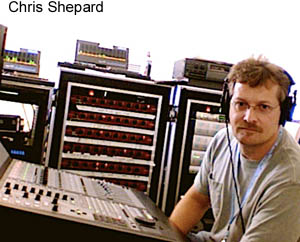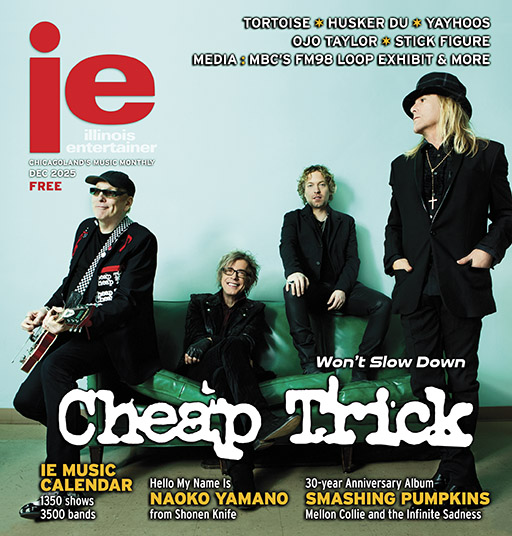On The Move
Count Chris Shepard, studio manager at Chicago Recording Company, as one of those who considered Lollapalooza 2006 a smashing success.
“When I looked out over the crowd at Lollapalooza and saw a sea of people and couldn’t see the end of it . . . in Chicago with the hometown backdrop and the city skyline, that was really moving,” Shepard says about the three-day festival in Grant Park. “That was unbelievable. For me there is no better place for music than right on that lakefront looking into the city.
“I mean we really hosted a fantastic festival. I get excited just talking about it with you. It was really moving.”

Of course Shepard had a slightly different view of the happenings in August than the rest of us in the crowd because he was in a soundbooth at the AT&T stage recording the likes of Kanye West, Red Hot Chili Peppers, Queens Of The Stone Age, and Gnarls Barkley. Nowadays Shepard finds himself on location, so to speak, a lot (when “Studiophile” talks to him he is preparing for a three-day Texas trip to record at Austin City Limits). It all started about five years ago when he found himself setting up remote recordings for numerous records, including Buddy Guy’s 2001 release, Sweet Tea. The demand gave birth to Chris Shepard’s Mobile Recording Studio – CMIX.
“Back then ProTools was still pretty infantile, but it was still very powerful compared to what 24-track tape was as a production tool,” he explains of his initial remote recording days. “Having a digital studio that was in road cases that could all be set up was very cost effective then.
“Now we do large remotes,” he continues. “We do large remotes; we carry 96 tracks of digital recording input in order to be able to have the backup plan you have to have to do these big shows. In the last two, three years we’re starting to get the main stages at these big festivals, these big Lollapaloozas, [Austin City Limits], Vegoose, Bonnaroo. We’re starting to get better and better stages, and I hope to be able to cover two stages coming up soon. ‘Cause the thing that they’ll pay for is someone who can sit there and actually mix it live. That’s the ticket. You’re not just going there, capturing it, and handing them a hard drive, you sit there and mix it live for Web casts; a lot of times the DVDs they’re releasing of these shows are the mixes we’re doing on the spot. There is only a few guys I know that can, not just sit there with an equalizer equalizing the kick drum or the snare . . . you’re balancing, constantly making sure the mix sounds good. That’s fun, that’s the hot seat.”
Live DVDs, Shepard says, are an easy way for bands to give fans a new product. Take industrial group KMFDM for example. Every time they play Chicago, Shepard records the gig, and the band have released two live DVDs in the last three years, and thanks to surround sound fans not only get the visual live experience, they also get the audio equivalent.
Shepard’s approach to mixing to surround is simple: Make listeners feel like they’re at the show. “I think of it as I like to be able to have really good seats,” he says. “When I go to a show I like to have a good seat, so that’s what I’m trying to give you – the best seat. That way you can hear everything great; you’re surrounded by people who are excited about it, and it feels [energetic]. Surround helps create that, that good seat feel.
“I never used to buy live CDs when I was a kid; I always liked the records, the albums, the Pink Floyd albums, you know? The live stuff just didn’t turn me on, but surround allows you to have those great tickets.”
But the hot seat Shepard previously referred to doesn’t always mean being perched in front of a giant stage at a packed festival or recording a club show for a DVD. Shepard and co. (generally a three-man crew) have hauled the remote studio (all 1,600 pounds can also be flown anywhere in the United States for less than a buck per pound) to theaters, abandoned buildings, grocery stores, and “just about anywhere you can think of,” Shepard says. “A lot of church stuff, especially choirs,” he adds. “You really want to catch them where they’re used to singing; you bring them into the studio you get about half. You just don’t get it. Studio’s great for mixing and making a record. But if you’re recording something that big it needs to be in the place.”
Often, Shepard has discovered, bringing the studio to the people instead of bringing the people to the studio, produces an inspired performance. And if that ends up being the case, Shepard stays out of the way.
“You’ve kind of already defused the nerve situation,” he says about recording people outside the studio. “That defuses a lot of the problems of recording for people without studio-chop experience. That always works in your favor especially if you work with a musical director who runs the show. Then you just try to be in the background. You try to let ’em forget the red button is even on – just let ’em do their thing.
“We let the artists . . . we don’t get in the way; they don’t know we’re there. We like it if they don’t even know they’re being recorded. That’s when you get the goods.”
To learn more about Shepard’s Mobile Recording Studio – CMIX call (312) 822-9333 or visit www.chicagorecording.com.
AT CHICAGO RECORDING COMPANY in Chicago, Wax On Radio worked in Studio Five and finished their new record, Exposition (Downtown Records). Mathieu Lejeune engineered, and Sean Geyer assisted . . . Atlantic Records artists Skillet were in residence for several months working on their new album, Camotose. Brian Howes produced, JVP engineered, and Dave Rieley and Geyer assisted . . . Ron Lowe engineered, mixed, and produced an album by Super No One, featuring Chip Z’nuff on bass. Rieley and Dusty Robbennolt assisted . . . Jeff Lane finished work on Shawna‘s new Def Jam album, Block Music. Matts Larson assisted . . . Plain White T’s performed live for Q101 radio; Chris Steinmetz engineered, and Grayson Taylor assisted . . . Death Cab For Cutie also recorded for Q101. Lejeune engineered, and Taylor and Robbennolt assisted . . . CRC’s mobile unit had a busy summer recording, to name just a few, Common and The Streets at Bonnaroo and Kanye West and The Red Hot Chili Peppers at Lollapalooza. Chris Shepard engineered; Stuart Holverson assisted.
Local rockers Red Seven recently completed recording and mixing their debut, Anywhere But Here, at CLEAN CUT STUDIOS in Palatine with engineer Jim Godsey (JBG Audio).
At SMART STUDIOS in Madison, Wisconsin, Voltress (featuring Roscoe Mitchell, Richard Davis, Bernie Worrell, and Corey Wilkes) finished mixing their experimental free jazz freak-out with engineer Beau Sorenson. The recording will be released this fall on vinyl through Cancer Records . . . Chicago band Wax On Radio recorded drums with Justin Perkins for songs for their new release . . . Milwaukee’s On A Sun continued work with engineer Mike Zirkel on their second record . . . The Cloud Room, a new project from Duke McVinnie, mixed their upcoming album with Brandon Mason . . . Studio owner Butch Vig worked on two different soundtracks.
At STUDIOCHICAGO in Chicago, Damien Marley (aka Junior Gong) and the Ghetto Youth stopped in for two late nights of tracking in Studio A . . . Legendary jazz drummer Danny Gottlieb flew in from Miami for a tracking session with local singer-songwriter Carol Williams. Gottlieb has previously worked with Pat Metheny and John McLaughlin during the later years of the Mahavishnu Orchestra . . . Local engineer Bob DiFazio teamed up with New York singer-songwriter Kyle Jones for full tracking and mixing to complete Jones’ newest album, The Phix Is In . . . Engineer Adam Frick brought in Ohio rockers 3 Legged Dog to track for an upcoming movie soundtrack.
Hey Studiophilers: To get your studio or band listed in “Studiophile,” just email info on whom you’re recording or who’s recording you to ieeditors@aol.com, subject Studiophile, or fax (312) 922-9369. We reserve the right to edit or omit submissions for space. Deadline for our November issue is October 10th.
– Trevor Fisher
Category: Monthly, Studiophile












Interesting story on Shepard. I think the future of recording
lies in the mobile experience, where band’s can capture
their sound on their home turf. Mix it in the studio, but capture
a real performance live.